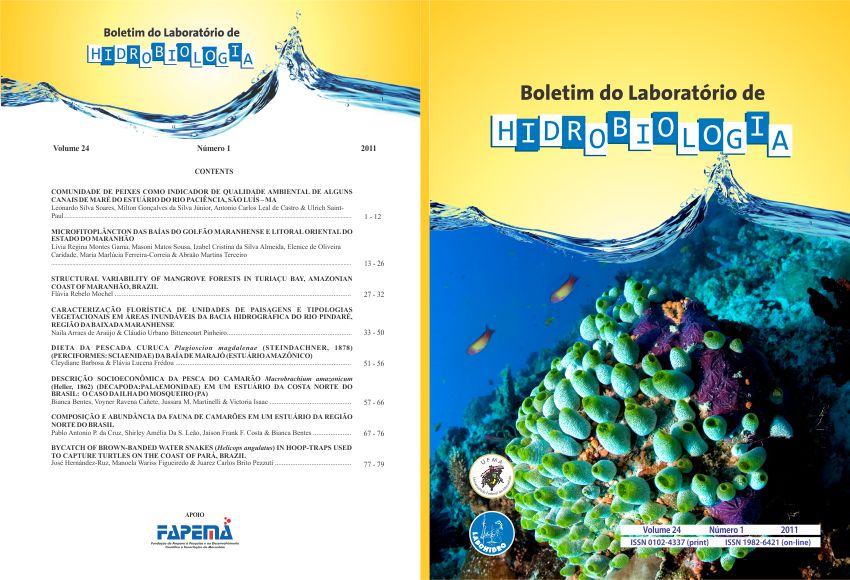BYCATCH OF BROWN-BANDED WATER SNAKES (Helicops angulatus) IN HOOP-TRAPS USED TO CAPTURE TURTLES ON THE COAST OF PARÁ, BRAZIL
DOI :
https://doi.org/10.18764/Résumé
Entre setembro de 2007 e agosto de 2009, foram executadas excursões de campo as ilhas da Romana e Maiandeua na costa brasileira do Estado do Pará, para a coleta de espécimes dos quelônios aquáticos (Rhinoclemmys punctularia e Kinosternon scorpioides) em lagoas naturais, utilizando armadilhas do tipo covo (hoop-nets). 35 exemplares da cobra aquática Helicops angulatus, foram capturados acidentalmente nas armadilhas. Além de quelônios, este procedimento pode ser utilizado para a amostragem de populações de serpentes aquáticas.
Palavras-chave: Métodos de amostragem, lagoas naturais.
ABSTRACT
Between September, 2007, and August, 2009, a number of field excursions were conducted on the northern Brazilian coast (Romana and Maiandeua islands in the state of Pará) for the collection of specimens of freshwater turtles (Rhinoclemmys punctularia and Kinosternon scorpioides) in natural ponds. Where hoop-nets were used, a number of specimens of brown-banded water snakes, Helicops angulatus, were captured as bycatch in the traps. In addition to turtles, then, the procedure may be useful for the sampling of populations of aquatic snakes.
Key words: Sampling methods, natural ponds.
Téléchargements
Références
ARESCO, M.J. 2009. Environmental correlates of the abundances of three species of freshwater turtles in lakes of Northern Florida. Copeia 2009: 545-555.
BURY, R.B. 1979. Population ecology of freshwater turtles, p. 571–602. In: Turtles: Perspectives and Research. M. Harless and H. Morlock (eds.). John Wiley & Sons, New York, NY. 695 pp.
DAUBLE, D.D. 1986. Life history and ecology of the large-scale sucker (Catostomus macrocheilus) in the Columbia River. Am. Midl. Nat., 116: 356–367.
FACHÍN-TERÁN, A., VOGT, R.C. & THORBJARNARSON, J.B. 2003. Estrutura populacional, proporção de sexos e abundância de Podocnemis sextuberculata (Testudines: Podocnemididae) na Reserva de Desenvolvimento Sustentável Mamirauá, Amazonas, Brasil. Phyllomedusa, 2: 43-63.
FACHÍN-TERÁN, A. & VOGT, R.C. 2004. Estrutura populacional, tamanho e razão sexual de Podocnemis unifilis (Testudines, Podocnemididae) no Rio Guaporé (RO), norte do Brasil. Phyllomedusa 3: 29-42.
FRATTO, Z.W., BARKO, V.A., PITTSC, P.R., SHERIFFD, S.L., BRIGGLERE, J.T., SULLIVANF, K.P., MCKEAGEG, B.L. & JOHNSONH, T.R. 2009. Evaluation of turtle exclusion and escapement devices for hoop-nets. J. Wildl. Manage., 72: 1628–1633.HUBERT, W.A. 1996. Passive capture techniques. Pages 157–175. In B. R. Murphy and D. W. Willis, (eds). Fisheries techniques. Second edition. American Fisheries Society, Bethesda, Maryland, USA. 732 P.
MUONEKE, M., MAUGHAN, O.E. & HENRY, C.C. 1993. Comparative capture efficiencies of frame and hoop nets for white crappie (Pomoxis annularis Rafinesque). Fisheries Res., 18: 231-240.
RÊBELO, G. H., PEZZUTI, J.C.B., LUGLI, L. & MOREIRA, G. 2005. Pesca artesanal de quelônios no Parque Nacional do Jaú (AM). Bol. Mus. Para. Emílio Goeldi, ser. Ciências Humanas 1: 109-125.
SAMUEL, N., NICKOL, B. B. & M. A. MAYES. 1976. Acanthocephala of Nebraska fishes. Am. Midl. Nat. 96: 391–406.
TILLMA, J.S., MILLIGAN, J. & GUY, C.S. 1997. Catch rates and size structure of two Ictularids sampled with different sized hoop-nets. J. Freshwat. Ecol., 12: 315–320.
VOGT, R.C. 2001. Turtles of the Rio Negro. Pp. 245-365. In: Conservation and Management of Ornamental Fish Resources of the Rio Negro Basin, Amazonia, Brazil – Project Piaba. N. L. CHAO (ed.). EDUA, Manaus – AM., 309 p.






